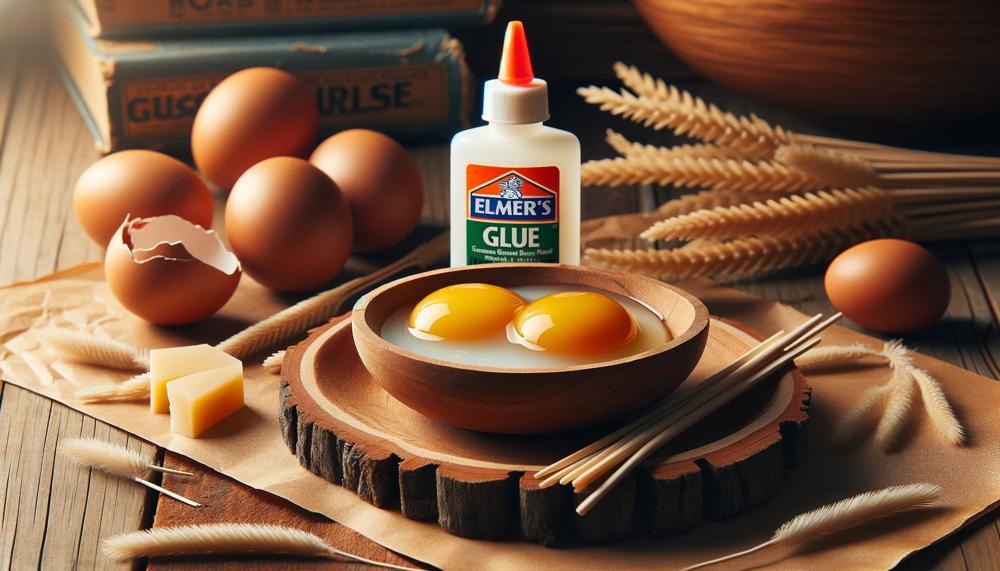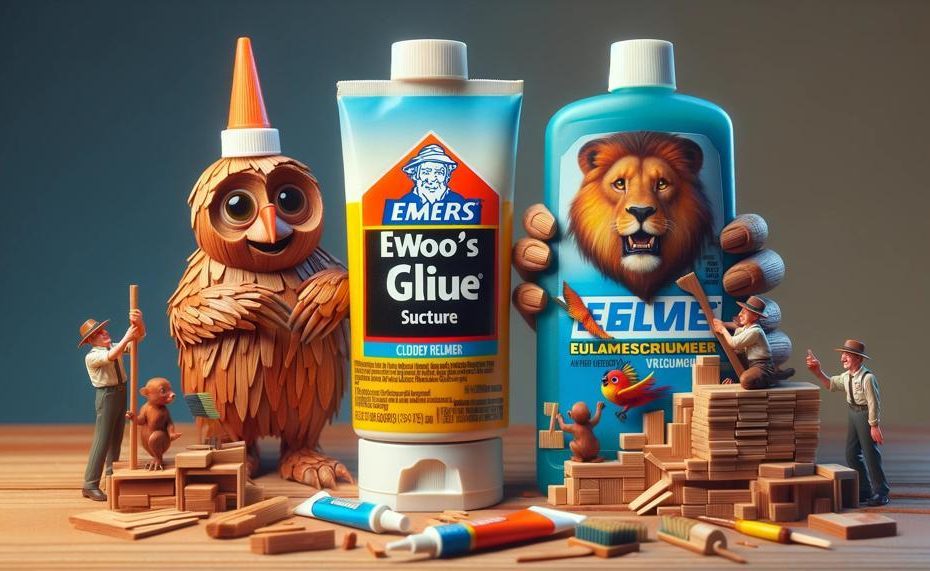Are you tired of constantly shelling out money for pricey wood glue that never seems to hold up? Well, what if we told you that the answer to your woodworking woes may be sitting right in your childhood craft drawer? That’s right – Elmer’s glue, the trusty adhesive used for paper mache and art projects, can also be a reliable and cost-effective alternative to traditional wood glue.
So, can i use elmers glue as wood glue?
Yes, you can use Elmer’s all-purpose glue on wood, but it will likely create a weaker bond than wood glue. The main difference between wood glue and white glue is that wood glue has a lower water content and is less likely to warp wood. White glue will break down in water, while wood glue will not.
In this blog post, we’ll delve into the details of using Elmer’s glue as wood glue. From application tips to its effectiveness on different types of wood, we’ve got you covered. Say goodbye to overpriced wood glue and hello to a budget-friendly solution that might just surprise you with its strength.
So let’s jump in and see how this childhood staple can revolutionize your woodworking game.
Table of Contents
- 1 What is Elmer’s Glue?
- 2 Can You Glue Wood with Elmer’s Glue?
- 3 Types of Elmer’s Glue for Gluing Wood
- 4 Preparing the Wood Surface for Gluing
- 5 Applying the Glue to the Wood
- 6 Clamping or Weighing Down the Pieces of Wood
- 7 Drying Time and Strength of Bond
- 8 Alternatives to Elmer’s Glue for Gluing Wood
- 9 Conclusion
What is Elmer’s Glue?
Elmer’s Glue, also known as white glue or school glue, is a brand of polyvinyl acetate (PVA) adhesive made from synthetic materials and water. Its safety for children is a distinguishing feature compared to other types of glue.
| Characteristic | Elmer’s Glue | Other Types of Glue |
| Adhesive Power | Less | More |
| Texture | Thin and runny | Thick and penetrating |
| Drying Process | 24 hours | 20-30 minutes |
| Waterproof Capability | No | Yes (for certain types) |
| Resistance to Heat | No | Yes (for certain types) |
Elmer’s Glue has a lower bonding strength compared to other industrial-grade adhesives, making it more suitable for lightweight projects like arts and crafts. Its consistency is thin and runny, making it effortless to apply on porous materials like paper and cardboard. However, this may result in weaker bonds with non-porous materials such as metal.
One of the significant differences between Elmer’s Glue and other types of glue is its drying time. It typically takes 24 hours to fully dry, which may not be ideal for projects with strict deadlines. Other types of glue, such as wood glue, dry much faster within 20-30 minutes.
Once dried, Elmer’s Glue is not waterproof and may not withstand outdoor or wet conditions. It also lacks heat resistance, making it unsuitable for projects that require such properties. Other types of glue may offer these features, depending on their intended use.
Can You Glue Wood with Elmer’s Glue?
While Elmer’s glue can be a substitute for wood glue, it may not be suitable for heavy-duty woodworking projects. It works well on porous woods like pine, cedar, and fir, but it may not provide enough bonding strength on non-porous woods like teak and mahogany.
| Wood Type | Recommended Glue |
| Porous Woods (e.g. Pine, Cedar, Fir) | Elmer’s Glue |
| Non-Porous Woods (e.g. Teak, Mahogany) | Polyurethane Glue, Epoxy, Hide Glue, Cyanoacrylate Glue |
For lightweight woodworking projects, Elmer’s glue can still provide a strong bond. However, for stronger and more durable bonds, it is best to use alternative adhesives such as polyurethane glue, epoxy, hide glue, or cyanoacrylate glue.
| Adhesive Type | Bonding Strength | Drying Time | Water Resistance |
| PVA Woodworking Glue (e.g. Elmer’s Glue) | Lower bonding strength | Longer drying time (around 24 hours) | Not water resistant |
| Polyurethane Glue | Strong bonding strength | Shorter drying time (around 20 minutes) | Water resistant |
| Epoxy | Strong bonding strength | Longer drying time (around 5 minutes) | Water resistant |
| Hide Glue | Strong bonding strength | Shorter drying time (around 20 minutes) | Not water resistant |
| Cyanoacrylate Glue (Super Glue) | Strong bonding strength | Shorter drying time (around 10 seconds) | Not water resistant |
It’s important to remember that when working with any type of adhesive, safety precautions should always be taken. This includes wearing protective gloves and working in a well-ventilated area.
Types of Elmer’s Glue for Gluing Wood
There are various types of Elmer’s glue that serve different purposes and have unique benefits when it comes to gluing wood. These include white school glue, Carpenter’s Wood Glue Max, Carpenter’s Exterior Wood Glue, Carpenter’s Interior Wood Glue Max, and Carpenter’s Ultimate Glue.
White school glue is the most commonly used type of Elmer’s glue for woodworking projects. It is perfect for general use and has the added bonus of drying clear, making it ideal for projects that require a clean and neat finish.
Carpenter’s Wood Glue Max is a popular choice among woodworkers who need a strong and durable bond. It sets quickly and can withstand heavy stress, making it suitable for high-impact projects.
For outdoor woodworking projects, Carpenter’s Exterior Wood Glue is the top choice as it is waterproof and can withstand exposure to the elements. This type of glue is also resistant to mold and mildew, making it perfect for outdoor furniture or structures.
On the other hand, if you need a fast-drying adhesive for indoor projects, Carpenter’s Interior Wood Glue Max is the go-to option. It dries quickly and provides a strong bond between wood pieces.
Lastly, Carpenter’s Ultimate Glue is the most versatile option for gluing wood. It is waterproof and can withstand tough conditions, making it suitable for both indoor and outdoor projects.
Preparing the Wood Surface for Gluing
Properly preparing a wood surface for gluing is crucial for achieving the best results.
There are several essential steps that should be taken, including cleaning, ensuring dryness, making it smooth and even, possibly applying a sealant, and preparing the wood glue itself.
Step 1: Clean the surface
To achieve a strong bond, it is important to ensure that the wood surface is free of any debris or dirt.
This can be achieved by lightly sanding with fine-grit sandpaper or using a tack cloth to remove any particles.
Step 2: Ensure dryness
Damp or wet wood will not bond effectively with glue and can result in a weak joint. If working with newly cut or treated wood, it is critical to allow it to dry completely before proceeding with gluing.
Step 3: Make the surface smooth and even
Any roughness or unevenness on the wood surface can create gaps between the glued pieces, resulting in a weak bond.
To achieve a smooth surface, it is recommended to sand the wood using progressively finer grit sandpaper until it feels smooth to the touch.
Step 4: Apply a sealant (if needed)
In some cases, a sealant may be necessary before gluing wood surfaces. This step is particularly important for porous woods like oak or maple.
A sealant can prevent excessive absorption of glue and create a more even surface for the glue to adhere to.
Step 5: Properly prepare the wood glue
It’s crucial to stir wood glue before use to ensure that all components are well mixed.
This activates the glue and ensures proper bonding. Additionally, some types of wood glue may require a specific setting time before clamping pieces together.
Applying the Glue to the Wood
When opting to use Elmer’s glue as a substitute for wood glue, it is crucial to properly prepare the wood surface beforehand. This includes cleaning it thoroughly and ensuring it is completely dry. The surface should also be smooth and even to ensure a strong bond can be created.
Additionally, it is highly recommended to apply a sealant before applying the glue to further enhance the bond.
To successfully utilize Elmer’s glue as wood glue, follow these steps:

- Prepare the surface: Begin by wiping the wood surface with a damp cloth to remove any dust or debris. Then, ensure that the surface is completely dry before proceeding.
- Apply a sealant (optional): For non-porous woods, it may be beneficial to apply a sealant before the glue to strengthen the bond. This step is optional but can greatly improve the overall strength of the bond.
- Apply a thin and even layer of glue: Using a brush or spreader, apply a thin and even layer of Elmer’s glue onto one of the wood pieces that will be bonded together.
- Clamp the wood pieces together: Once the glue has been applied, carefully place the two wood pieces together in the desired position. Secure them with clamps to ensure a strong bond.
- Allow time for drying: Depending on the type of project and amount of glue used, drying times may vary. It is recommended to leave the clamps on for at least an hour and allow 24 hours for the glue to fully dry before handling or using the project.
By following these steps, you can successfully create a strong bond when using Elmer’s glue as wood glue. However, it is important to note that this method may not be suitable for all types of wood and alternative glues may be necessary for certain projects. It is always best to test on a small area first before proceeding with larger projects.
Clamping or Weighing Down the Pieces of Wood
It is highly recommended to use clamps or weights when substituting Elmer’s glue for wood glue. This will ensure a strong bond and prevent the pieces from shifting or moving while the glue dries.
Using Clamps:
Selecting the right size clamp is crucial for the project. The clamp should provide enough pressure to keep the pieces firmly together without causing damage. It’s also essential to evenly distribute the pressure across the surface to avoid any uneven bonding.
Using Weights:
If clamps are not available, weights can also be used as an alternative. However, this method may not be as effective as using clamps since it only applies pressure on the top surface and not along the entire bond.
Table: Comparison between using clamps and weights when substituting Elmer’s glue for wood glue
| Clamps | Weights | |
|---|---|---|
| Effectiveness | Highly effective in creating a strong bond | May not be as effective as clamps |
| Application | Applies pressure evenly along the entire bond | Only applies pressure on the top surface |
| Availability | Can be easily purchased or rented from hardware stores | May not be readily available |
| Cost | Can be expensive depending on size and type | Can be more cost-effective than buying clamps |
| Versatility | Can be used for various woodworking projects | Limited use for specific projects only |
Drying Time and Strength of Bond
The drying time and strength of bond for Elmer’s glue may vary depending on the type of glue and environmental conditions. Generally, it takes 20-30 minutes for initial bonding and requires 24 hours to fully cure.
However, the strength of the bond may differ depending on the specific type of wood glue used.
| Glue Type | Drying Time | Curing Time |
| Elmer’s School Glue | 30 minutes – 1 hour | 24 hours |
| Elmer’s Glue Sticks | Almost immediate | N/A |
| Traditional Wood Glue | 20-30 minutes | 24 hours |
| Elmer’s White Glue | 30 minutes | 24 hours |
| Elmer’s Glue-All | 20-30 minutes | 24 hours |
As shown in the table, Elmer’s glue has comparable drying times to traditional wood glue. However, the strength of the bond may differ due to the specific ingredients and formulas used in each type of glue.
Alternatives to Elmer’s Glue for Gluing Wood
If you’re working on a woodworking project, Elmer’s glue may not always be the best option for a strong and durable bond. Luckily, there are alternative adhesives available, such as white school glue, carpenter’s glue or wood glue, PVA glue, cyanoacrylate or superglue, epoxy, and polyurethane glue.
Each of these alternatives has its own unique pros and cons when it comes to strength and effectiveness.
| Alternative Adhesive | Strength | Effectiveness |
| White School Glue (PVA) | Medium | Not strong enough for permanent bonds on wood |
| Carpenter’s Glue or Wood Glue | Strong | Durable bond for woodworking projects |
| PVA Glue | Medium | Versatile and non-toxic, but not strong enough for permanent bonds on wood |
| Cyanoacrylate or Superglue | Very Strong | Bonds quickly and strongly, but can be brittle and not suitable for larger projects |
| Epoxy | Very Strong | Durable and water-resistant bond, but longer curing time and requires proper surface preparation |
| Polyurethane Glue | Strongest option | Durable and water-resistant bond, but longer curing time and can be messy to work with |
While Elmer’s glue typically dries in 20-30 minutes and fully cures in 24 hours, the alternatives may have different drying and curing times. PVA glue and cyanoacrylate or superglue have a quick bonding time, while epoxy and polyurethane glue may take longer to cure. Keep in mind that proper surface preparation of the wood is crucial before applying any type of adhesive for a strong and durable bond.
In terms of strength, carpenter’s glue or wood glue, cyanoacrylate or superglue, epoxy, and polyurethane glue are considered stronger options compared to Elmer’s glue. However, the type of wood being used may also affect the strength of the bond.
Conclusion
In conclusion, Elmer’s glue can be a reliable and cost-effective alternative to traditional wood glue.
Its water-based formula not only makes it non-toxic and easy to clean up, but also provides a strong bond that can withstand everyday wear and tear. With its availability in various sizes at most stores, it is convenient for all your woodworking needs.
However, keep in mind that it may not be suitable for heavy-duty projects or non-porous woods. Proper surface preparation and consideration of factors such as drying time and bonding strength are crucial when using Elmer’s glue for woodworking.
While it may not always be the top choice, don’t underestimate this childhood staple – its strength and versatility just might surprise you. So next time you’re working on a project, give Elmer’s glue a chance to shine.






